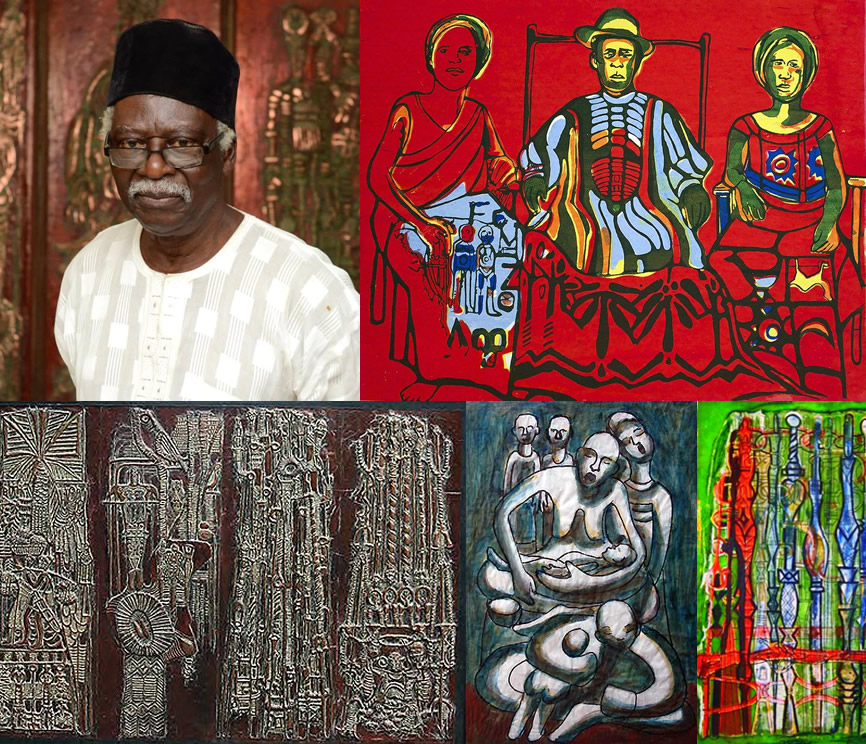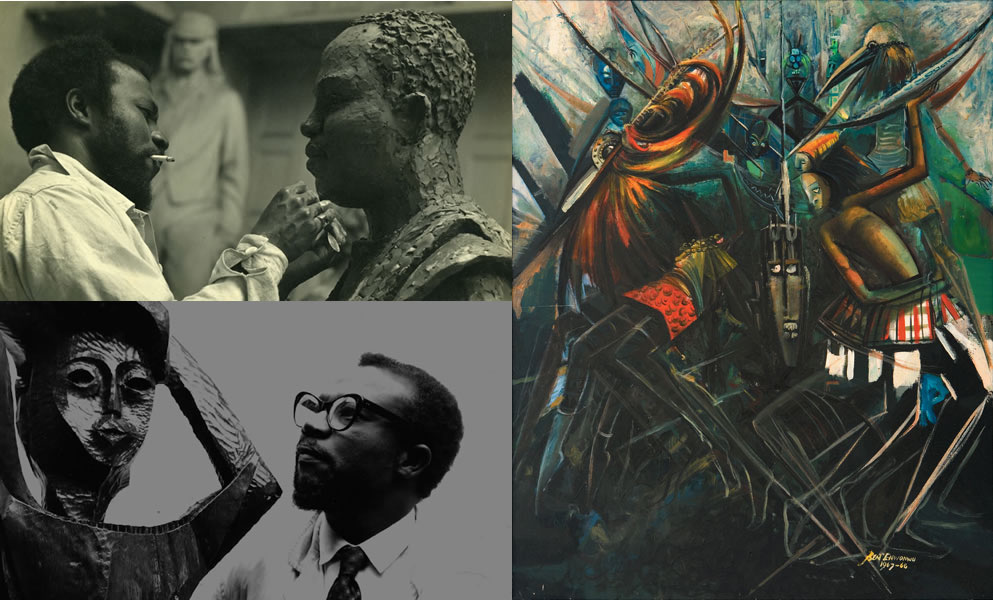Home > Artist on Focus
Tola Wewe, born in Okitipupa, Ondo State, Nigeria in 1959, trained and graduated with a degree in Fine Art from University of Ife in 1983. He then went on to obtain a Masters degree in African Visual Arts from University of Ibadan, Oyo State in 1986. Tola Wewe worked as a cartoonist before becoming a full time studio artist in 1991.
At the beginning of his career, three major influences characterised Tola Wewe's works; the first was his basic academic training at Ife, the second his masters research programme in the Ijaw water spirit mask and thirdly the society particularly the Yoruba society. His style draws from the Ona symbols of the Yoruba and his themes project traditional lore and myths of his native Yoruba culture. Wewe describes himself more as a witness than an author, "communicating with the spirits of the ancestors, and drawing out the invisible spirits - the anjonnu, emere and the ebora - who make the art works…I am the vehicle, and they are the drivers. We go on these strange journeys to the most remote ends of imaginative experience."
His work, defiant of classification, 'silently grows on viewers, blending with their moods, simultaneously taking their minds to strange and familiar colourful places full of false nostalgia. Often the attraction is mutual and instant: for those who can consume the spectacular banquet of colours, Wewe cooks up spicy visual rhythms, sometimes playful, sometimes serious, sometimes dense, sometimes scattered, carefully orchestrated, although seemingly extravagant.' (Moyo Okediji, University of Colorado).
Tola Wewe is a founding member of the Ona movement which emerged in February 1989. The movement is a group of scholars, critics and practicing artists committed to pursuing artistic excellence through the adaptation and interpretation of traditional materials & methods, forms & styles of contemporary Yoruba art and design.
Tola Wewe was also a Commissioner for Culture and Tourism in Ondo State in Nigeria. Even while holding a governmental position, he continued to find time to paint whilst promoting tourism in Ondo which contributed to Nigerian tourism as a whole. During his tenure, he was responsible for the organisation of the Mare annual Festival, which involved mountain climbing, cultural activities like music, dance, drama and marathon race. He also organised the first international conference on culture in Akure, where international scholars, culture practitioners from different parts of the world came together to discuss ‘Culture and the Challenges of Development in Nigeria.’
Tola Wewe, whose works are widely acclaimed for their originality, simplicity, surface texture and mastery of colours, is considered one of the most talented minds from the African continent. His work is a hybrid of African and western sensibilities and images, reflecting his own training and experience as an international artist. Beyond Nigeria, Tola Wewe's work has been exhibited across Europe and the US. As a full time artist, he lives and works in Ondo State, Nigeria.
Sources:
http://jonaquestart.com
http://www.themojogallery.com
Tola Wewe
Tola Wewe, born in Okitipupa, Ondo State, Nigeria in 1959, trained and graduated with a degree in Fine Art from University of Ife in 1983. He then went on to obtain a Masters degree in African Visual Arts from University of Ibadan, Oyo State in 1986. Tola Wewe worked as a cartoonist before becoming a full time studio artist in 1991.
At the beginning of his career, three major influences characterised Tola Wewe's works; the first was his basic academic training at Ife, the second his masters research programme in the Ijaw water spirit mask and thirdly the society particularly the Yoruba society. His style draws from the Ona symbols of the Yoruba and his themes project traditional lore and myths of his native Yoruba culture. Wewe describes himself more as a witness than an author, "communicating with the spirits of the ancestors, and drawing out the invisible spirits - the anjonnu, emere and the ebora - who make the art works…I am the vehicle, and they are the drivers. We go on these strange journeys to the most remote ends of imaginative experience."
His work, defiant of classification, 'silently grows on viewers, blending with their moods, simultaneously taking their minds to strange and familiar colourful places full of false nostalgia. Often the attraction is mutual and instant: for those who can consume the spectacular banquet of colours, Wewe cooks up spicy visual rhythms, sometimes playful, sometimes serious, sometimes dense, sometimes scattered, carefully orchestrated, although seemingly extravagant.' (Moyo Okediji, University of Colorado).
Tola Wewe is a founding member of the Ona movement which emerged in February 1989. The movement is a group of scholars, critics and practicing artists committed to pursuing artistic excellence through the adaptation and interpretation of traditional materials & methods, forms & styles of contemporary Yoruba art and design.
Tola Wewe was also a Commissioner for Culture and Tourism in Ondo State in Nigeria. Even while holding a governmental position, he continued to find time to paint whilst promoting tourism in Ondo which contributed to Nigerian tourism as a whole. During his tenure, he was responsible for the organisation of the Mare annual Festival, which involved mountain climbing, cultural activities like music, dance, drama and marathon race. He also organised the first international conference on culture in Akure, where international scholars, culture practitioners from different parts of the world came together to discuss ‘Culture and the Challenges of Development in Nigeria.’
Tola Wewe, whose works are widely acclaimed for their originality, simplicity, surface texture and mastery of colours, is considered one of the most talented minds from the African continent. His work is a hybrid of African and western sensibilities and images, reflecting his own training and experience as an international artist. Beyond Nigeria, Tola Wewe's work has been exhibited across Europe and the US. As a full time artist, he lives and works in Ondo State, Nigeria.
Sources:
http://jonaquestart.com
http://www.themojogallery.com
Artist on Focus
Dele Jegede

Dr. dele jegede, Professor Emeritus of Miami University, Oxford, Ohio, has over four decades of experience as artist, art historian, painter, cartoonist, art critic, curator, and art administrator.
[Continue reading]
Uche Okeke

Christopher Uchefuna Okeke was born on 30 April 1933 in Nimo, Njikoka Local Government Area of Anambra State, Nigeria, to Isaac Okonkwo Okeke and Monica Mgboye Okeke (née Okoye). Between 1940 and 1...
[Continue reading]
Bruce Onobrakpeya

Bruce Onobrakpeya born in Agbarha-Otor, Delta State, Nigeria in 1932, is one of African’s best known and most highly respected artists. A printmaker, painter and sculptor, he has been described...
[Continue reading]
Ben Enwonwu

Enwonwu, Benedict (Ben) Chukwukadibia (1921 – 1994) Artist, Painter, Sculptor was born a twin on July 14th, 1921 in Onitsha, Anambra State, Nigeria in to the noble family of Umueze-Aroli in Oni...
[Continue reading]
Nike Davies-Okundaye

Chief (Mrs) Nike Davies-Okundaye was born in 1951 in Ogidi-Ijumu, Kogi State, Nigeria. She was brought up amidst the traditional weaving and dying practice in her native village of Ogidi in Western Ni...
[Continue reading]
Yusuf Grillo
Yusuf Grillo (born 1934) is a contemporary Nigerian artist known for his inventive works and the prominence of the color blue in many of his paintings. He was president of the Society of Nigerian Arti...
[Continue reading]
[First Page] [Prev] Page 8 of 8